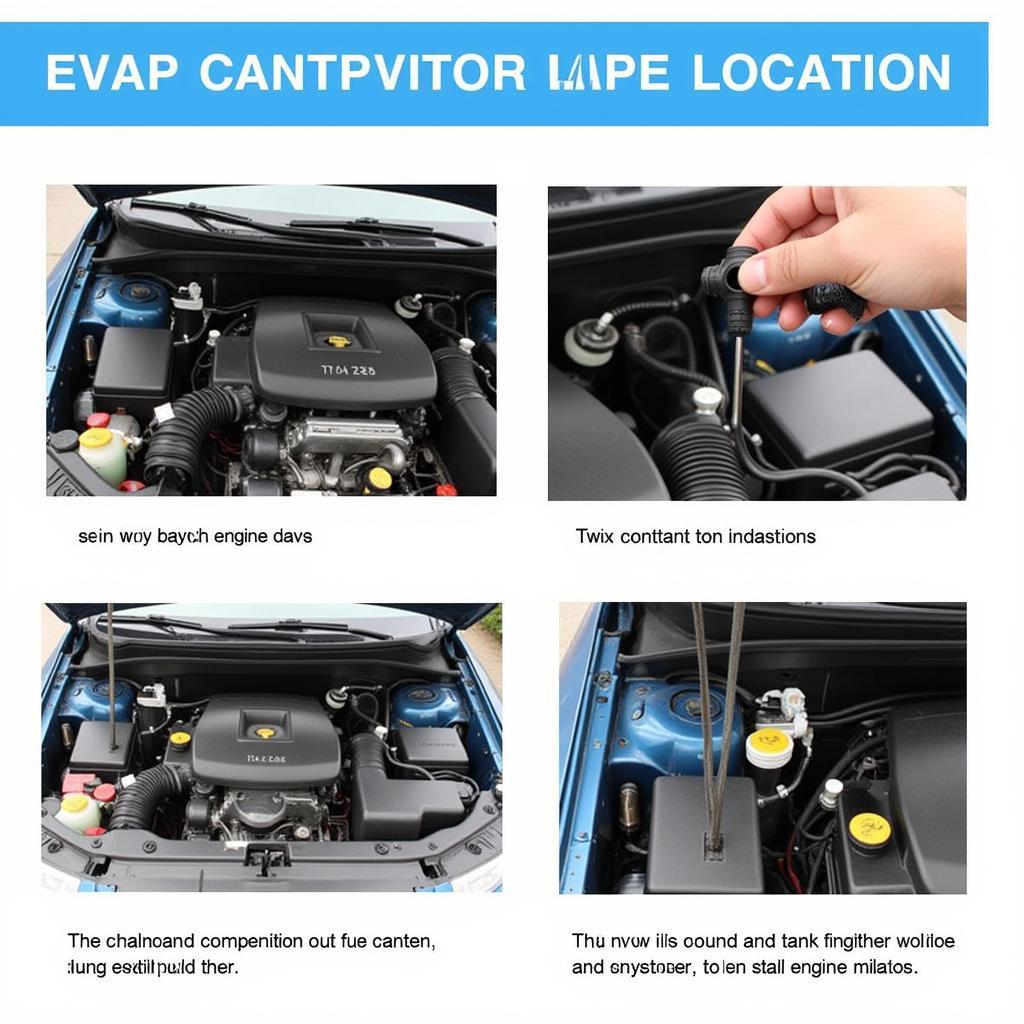The dreaded check engine light illuminates your dashboard. Your car might be running rough, or perhaps you’re noticing poor fuel economy. Could the culprit be the Car Problems E Vap Vent Valve? This article delves into the intricacies of the evaporative emission control system (EVAP) and its vent valve, providing you with the knowledge to diagnose and potentially fix this common automotive issue.
 EVAP Vent Valve Location
EVAP Vent Valve Location
The EVAP system is crucial for preventing fuel vapors from escaping into the atmosphere. These vapors, containing harmful hydrocarbons, are captured and stored in a charcoal canister. The e vap vent valve plays a vital role in regulating the flow of air into this canister, allowing the stored vapors to be purged into the engine for combustion. A malfunctioning vent valve can disrupt this process, leading to a range of drivability and emissions problems.
Understanding the E-VAP Vent Valve’s Function
The e vap vent valve acts as a gatekeeper, controlling the airflow into the charcoal canister. When the valve is closed, it prevents outside air from entering the canister, sealing in the captured fuel vapors. When open, it allows air to flow into the canister, creating the necessary pressure differential for purging the vapors into the intake manifold. This precise control is essential for maintaining proper fuel system pressure and reducing emissions. cars with most problems 2022 often highlight issues with the EVAP system, including the vent valve.
Common Symptoms of a Faulty E-VAP Vent Valve
A faulty e vap vent valve can manifest in several ways:
- Check Engine Light: This is the most common indicator. The onboard diagnostic system (OBD-II) will detect a malfunction and trigger the check engine light.
- Rough Idle: The engine may run unevenly at idle due to the imbalance in the air-fuel mixture caused by the faulty valve.
- Poor Fuel Economy: A leaking or stuck-open vent valve can lead to wasted fuel and reduced mileage.
- Fuel Smell: A strong gasoline odor may be present, indicating a leak in the EVAP system, possibly stemming from the vent valve.
- Failed Emissions Test: A malfunctioning EVAP system, including the vent valve, can cause your vehicle to fail emissions testing.
Diagnosing an E-VAP Vent Valve Problem
Diagnosing an e vap vent valve issue involves several steps:
- Retrieve Diagnostic Trouble Codes (DTCs): Use an OBD-II scanner to read the trouble codes stored in the car’s computer. Codes related to the EVAP system, such as P0440, P0441, P0442, P0446, and P0455, can point towards a vent valve problem.
- Visual Inspection: Inspect the vent valve and its associated hoses and connections for any signs of damage, cracks, or loose fittings.
- Valve Testing: Use a multimeter to test the electrical resistance of the vent valve solenoid. Compare the readings to the manufacturer’s specifications.
- Smoke Test: A smoke test can help pinpoint leaks in the EVAP system, including the vent valve.
“A thorough diagnosis is crucial before replacing any parts,” says automotive expert John Miller, ASE Certified Master Technician. “Often, a simple loose connection or cracked hose can be the culprit, not the vent valve itself.”
car problems com offers more information on various car problems.
Replacing the E-VAP Vent Valve
Replacing the e vap vent valve is typically a straightforward process:
- Disconnect the Battery: Always disconnect the negative battery terminal before working on any electrical components.
- Locate the Vent Valve: Consult your vehicle’s repair manual for the exact location of the vent valve.
- Disconnect Hoses and Electrical Connector: Carefully remove the hoses and electrical connector attached to the vent valve.
- Remove the Old Valve: Unscrew or unclip the old vent valve from its mounting bracket.
- Install the New Valve: Install the new vent valve and reconnect the hoses and electrical connector.
- Reconnect the Battery: Reconnect the negative battery terminal.
- Clear Diagnostic Trouble Codes: Use the OBD-II scanner to clear the stored trouble codes.
Conclusion
Addressing car problems e vap vent valve issues is crucial for maintaining your vehicle’s performance and minimizing its environmental impact. By understanding the function of the EVAP system and its vent valve, along with common symptoms and diagnostic procedures, you can effectively troubleshoot and resolve these problems. steering problems car can also be indicative of other underlying issues. For further assistance, contact us at AutoTipPro at +1 (641) 206-8880 or visit our office at 500 N St Mary’s St, San Antonio, TX 78205, United States. We are here to help!
“Regular maintenance, including checking for EVAP system leaks, can prevent costly repairs down the road,” adds Maria Sanchez, another seasoned automotive technician. 2003 lincoln town car power steering problems demonstrate the importance of regular checkups. steering problems in car should never be ignored.






Leave a Reply